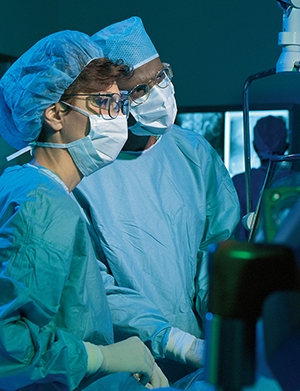Heart Failure: Procedures That May Help
Treating artery and valve problems
If you have blocked arteries to the heart (coronary artery disease) or valve disease, procedures may be done to improve blood flow. This helps the heart pump better, which can improve heart failure symptoms. First, your doctor may do a cardiac catheterization to help detect clogged blood vessels or valve damage. During this procedure, a thin tube (catheter) in inserted into a blood vessel and guided to the heart. There a dye is injected and a special type of X-ray (angiogram) is taken of the blood vessels. Procedures to open a blocked artery or fix damaged valves can also be done using catheterization.
-
Angioplasty uses a balloon-tipped instrument at the end of the catheter. The balloon is inflated to widen the narrowed artery. In many cases, a stent is expanded to further support the narrowed artery. A stent is a metal mesh tube.
-
Valve surgery repairs or replacement of faulty valves can also be done during catheterization so blood can flow properly through the chambers of the heart.
Bypass surgery is another option to help treat blocked arteries. It uses a healthy blood vessel from elsewhere in the body. The healthy blood vessel is attached above and below the blocked area so that blood can flow around the blocked artery.
Treating heart rhythm problems
A device may be placed in the chest to help a weak heart maintain a healthy heartbeat so the heart can pump more effectively:
-
Pacemaker. A pacemaker is an implanted device that regulates your heartbeat electronically. It monitors your heart's rhythm and generates a painless electric impulse that helps the heart beat in a regular rhythm. A pacemaker is programmed to meet your specific heart rhythm needs.
-
Biventricular pacing/cardiac resynchronization therapy. A type of pacemaker that paces both pumping chambers of the heart at the same time to coordinate contractions and to improve the heart's function. Some people with heart failure are candidates for this therapy.
-
Implantable cardioverter defibrillator. A device similar to a pacemaker that senses when the heart is beating too fast and delivers an electrical shock to convert the fast rhythm to a normal rhythm. This can be a life saving device.
Treating high pressure in the lungs
CardioMEMS is an FDA-approved heart failure monitoring system that helps patients experiencing high pressures in the heart and lungs. The system informs patients of any ongoing pressure, detects fluid buildup, and is proven to reduce hospital admissions and readmission.
In severe cases
In more serious cases of heart failure when other treatments no longer work, other options may include:
-
Ventricular assist devices (VADs). These are mechanical devices used to take over the pumping function for one or both of the heart's ventricles, or pumping chambers. A VAD may be necessary when heart failure progresses to the point that medicines and other treatments no longer help. In some cases, a VAD may be used as a bridge to transplant.
-
Heart transplant. This is replacing the diseased heart with a healthy one from a donor. This is an option for a few people who are very sick. A heart transplant is very serious and not an option for all patients. Your doctor can tell you more.
